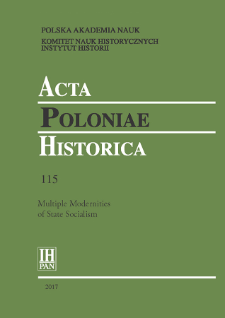- Search in all Repository
- Literature and maps
- Archeology
- Mills database
- Natural sciences
Advanced search
Advanced search
Advanced search
Advanced search
Advanced search

Object
Title: A ‘great change’, or, the Poles’ unfulfiled daydream about having a car (1956-7)
Subtitle:
Acta Poloniae Historica T. 115 (2017)
Contributor:
Korecki, Tristan : Trans. ; Institute of History of the Polish Academy of Sciences ; Polish National Historical Committee
Publisher:
Place of publishing:
Description:
Type of object:
Abstract:
The political ‘Thaw’ of 1956-7 was in Poland a period of thorough political as well as cultural and social change. While the political liberalisation came to an end rather soon, the team of Władysław Gomułka, the newly-appointed First Secretary of the Central Committee of the Polish United Workers’ Party [PZPR], in power since October 1956, cared much for maintaining and reinforcing their pro-social and reformatory image. The leadership team’s assent for a more sophisticated consumption, part of which was owning a car, helped alleviate social tensions. The models were drawn from the West of Europe and from the United States, which for the Polish society were the major points of reference, as well as from the other socialist countries - particularly, East Germany (the GDR) and Czechoslovakia, where the political and societal significance of motorisation had already been appreciated. On the other hand, offering private individuals an opportunity to purchase a car was meant to be a remarkable tool used to draw the ‘hot money’ down from the market, thus preventing inflation. Cars, imported or Polish-made, began being (relatively) freely traded, at very high prices. This did not limit the demand, as acquiescence for private business operations contributed to the growing of the group of affluent people. While this incited the citizens to develop their own strategies of acquiring cars - not infrequently colliding with the law; the authorities began gradually reinstating the rationing. All the same, the number of private cars quickly increased, to 58,600 as of 1958, up from some 24,750 in 1956. Public discussion started around popular low-capacity (small-engine) cars - whether licensed (Renault, Simca, Fiat) or (to be) made in Poland. However, in spite of the raised expectations the authorities decided that it was still too early for a mass motorisation: this was made possible only in the early 1970s.
References:
Gatejel Luminita, Warten, hoffen und endlich fahren. Auto und Sozialismus in der Sowjetunion, in Rumänien und der DDR (1956-1989/91) (Frankfurt am Main and New York, 2014).
Haustein Sabine, Vom Mangel zum Massenkonsum. Deutschland, Frankreich und Großbritannien im Vergleich, 1945-1970 (Frankfurt am Main and New York, 2007).
Kaelble Hartmut, Sozialgeschichte Europas: 1945 bis zur Gegenwart (München, 2007).
Kochanowski Jerzy and Puttkamer Joachim von (eds.),1956. (Nieco) inne spojrzenie. Eine (etwas) andere Perspektive (Warszawa, 2016).
Kuhr-Korolev Corinna and Grieger Manfred (eds.), Towards Mobility. Varieties of Automobilism in East and West (Wolfsburg, 2009).
Mezer Jerzy de, Cywilizacja motocyklowa. Motoryzacja motocyklowa w Polsce 1945-1965 (Warszawa, 2011) [e-book].
Mórawski Karol J., Syrena. Samochód PRL (Warszawa, 2005).
Reid Susan E. and Crowley David (eds.), Style and Socialism. Modernity and Material Culture in Post-War Eastern Europe (Oxford and New York, 2000).
Ruppert Wolfgang (ed.), Fahrrad, Auto, Fernsehschrank. Zur Kulturgeschichte der Alltagsdinge (Frankfurt am Main, 1993).
Schildt Axel, Moderne Zeiten: Freizeit, Massenmedien und “Zeitgeist” in der Bundesrepublik der 50er Jahre (Hamburg, 1995).
Siegelbaum Lewis H. (ed.), The Socialist Car: Automobility in the Eastern Bloc (Ithaca, NY, 2011).
Siegelbaum Lewis H., Cars for Comrades. The Life of the Soviet Automobile (Ithaca, NY, 2008).
Wildt Michael, Am Beginn der “Konsumgesellschaft”. Mangelerfahrung, Lebenshaltung, Wohlstandshoffnung in Westdeutschland in den fünfziger Jahren (Hamburg, 1995).
Wilk Hubert, ‘“Nawet samochodów nie ma, zostały graty po Niemcach” - motoryzacyjny punkt startu - Polska 1944-1949’, Polska 1944/45-1989. Studia i Materiały, xii (2014), 301-30.
Wilk Hubert, ‘Samochód dla towarzysza Wiesława. Dyskusje nad kierunkiem rozwoju motoryzacji indywidualnej w Polsce 1955-1970’, Polska 1944/45-1989. Studia i Materiały, xi (2013), 277-96.
Relation:
Volume:
Start page:
End page:
Detailed Resource Type:
Format:
Resource Identifier:
oai:rcin.org.pl:63829 ; 0001-6829 ; 10.12775/APH.2017.115.03
Source:
IH PAN, sygn. A.295/115 Podr. ; IH PAN, sygn. A.296/115 ; click here to follow the link
Language:
Rights:
Creative Commons Attribution BY-ND 4.0 license
Terms of use:
Copyright-protected material. [CC BY-ND 4.0] May be used within the scope specified in Creative Commons Attribution BY-ND 4.0 license, full text available at: ; -
Digitizing institution:
Institute of History of the Polish Academy of Sciences
Original in:
Library of the Institute of History PAS
Access:
Object collections:
- Digital Repository of Scientific Institutes > Partners' collections > Institute of History PAS > Serials
- Digital Repository of Scientific Institutes > Partners' collections > Institute of History PAS > Institute Publications
- Digital Repository of Scientific Institutes > Partners' collections > Institute of History PAS > Institute Publications > Journals
- Digital Repository of Scientific Institutes > Partners' collections > Institute of History PAS > Institute Publications > Journals > Acta Poloniae Historica
- Digital Repository of Scientific Institutes > Literature > Journals/Articles
Last modified:
Sep 22, 2023
In our library since:
Nov 29, 2017
Number of object content downloads / hits:
894
All available object's versions:
https://rcin.org.pl./publication/83484
Show description in RDF format:
Show description in RDFa format:
Show description in OAI-PMH format:
| Edition name | Date |
|---|---|
| Kochanowski, Jerzy (1960- ), A ‘great change’, or, the Poles’ unfulfiled daydream about having a car (1956-7) | Sep 22, 2023 |
Objects Similar
„Nawet samochodów nie ma, zostały graty po Niemcach” – motoryzacyjny punkt startu – Polska 1944–1949
Wilk, Hubert (1979– )
Chojnowski, Andrzej (1945– )
Kochanowski, Jerzy (1960– )
Kochanowski, Jerzy (1960– )
Wilk, Hubert (1979– )
Przeperski, Michał (1986– )
Jarosz, Dariusz (1959– )

 INSTYTUT ARCHEOLOGII I ETNOLOGII POLSKIEJ AKADEMII NAUK
INSTYTUT ARCHEOLOGII I ETNOLOGII POLSKIEJ AKADEMII NAUK
 INSTYTUT BADAŃ LITERACKICH POLSKIEJ AKADEMII NAUK
INSTYTUT BADAŃ LITERACKICH POLSKIEJ AKADEMII NAUK
 INSTYTUT BADAWCZY LEŚNICTWA
INSTYTUT BADAWCZY LEŚNICTWA
 INSTYTUT BIOLOGII DOŚWIADCZALNEJ IM. MARCELEGO NENCKIEGO POLSKIEJ AKADEMII NAUK
INSTYTUT BIOLOGII DOŚWIADCZALNEJ IM. MARCELEGO NENCKIEGO POLSKIEJ AKADEMII NAUK
 INSTYTUT BIOLOGII SSAKÓW POLSKIEJ AKADEMII NAUK
INSTYTUT BIOLOGII SSAKÓW POLSKIEJ AKADEMII NAUK
 INSTYTUT CHEMII FIZYCZNEJ PAN
INSTYTUT CHEMII FIZYCZNEJ PAN
 INSTYTUT CHEMII ORGANICZNEJ PAN
INSTYTUT CHEMII ORGANICZNEJ PAN
 INSTYTUT FILOZOFII I SOCJOLOGII PAN
INSTYTUT FILOZOFII I SOCJOLOGII PAN
 INSTYTUT GEOGRAFII I PRZESTRZENNEGO ZAGOSPODAROWANIA PAN
INSTYTUT GEOGRAFII I PRZESTRZENNEGO ZAGOSPODAROWANIA PAN
 INSTYTUT HISTORII im. TADEUSZA MANTEUFFLA POLSKIEJ AKADEMII NAUK
INSTYTUT HISTORII im. TADEUSZA MANTEUFFLA POLSKIEJ AKADEMII NAUK
 INSTYTUT JĘZYKA POLSKIEGO POLSKIEJ AKADEMII NAUK
INSTYTUT JĘZYKA POLSKIEGO POLSKIEJ AKADEMII NAUK
 INSTYTUT MATEMATYCZNY PAN
INSTYTUT MATEMATYCZNY PAN
 INSTYTUT MEDYCYNY DOŚWIADCZALNEJ I KLINICZNEJ IM.MIROSŁAWA MOSSAKOWSKIEGO POLSKIEJ AKADEMII NAUK
INSTYTUT MEDYCYNY DOŚWIADCZALNEJ I KLINICZNEJ IM.MIROSŁAWA MOSSAKOWSKIEGO POLSKIEJ AKADEMII NAUK
 INSTYTUT PODSTAWOWYCH PROBLEMÓW TECHNIKI PAN
INSTYTUT PODSTAWOWYCH PROBLEMÓW TECHNIKI PAN
 INSTYTUT SLAWISTYKI PAN
INSTYTUT SLAWISTYKI PAN
 SIEĆ BADAWCZA ŁUKASIEWICZ - INSTYTUT TECHNOLOGII MATERIAŁÓW ELEKTRONICZNYCH
SIEĆ BADAWCZA ŁUKASIEWICZ - INSTYTUT TECHNOLOGII MATERIAŁÓW ELEKTRONICZNYCH
 MUZEUM I INSTYTUT ZOOLOGII POLSKIEJ AKADEMII NAUK
MUZEUM I INSTYTUT ZOOLOGII POLSKIEJ AKADEMII NAUK
 INSTYTUT BADAŃ SYSTEMOWYCH PAN
INSTYTUT BADAŃ SYSTEMOWYCH PAN
 INSTYTUT BOTANIKI IM. WŁADYSŁAWA SZAFERA POLSKIEJ AKADEMII NAUK
INSTYTUT BOTANIKI IM. WŁADYSŁAWA SZAFERA POLSKIEJ AKADEMII NAUK




































